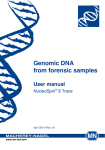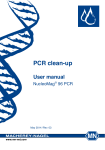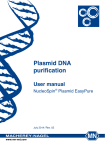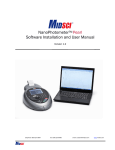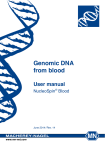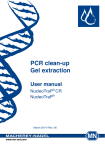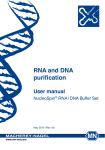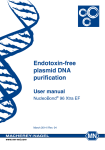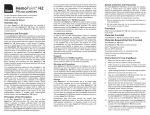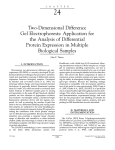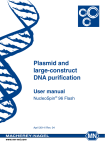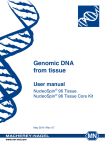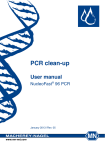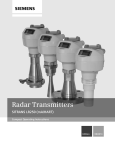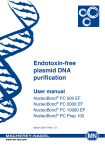Download Protein Quantification Assay - MACHEREY
Transcript
Protein Quantification Assay User manual May 2014 / Rev. 04 Protein Quantification Assay Protocol-at-a-glance (Rev. 04) Microplate assay Semi–micro cuvette assay Micro cuvette assay Low volume assay Dispense 50 μL PSB per tube # 2–# 7 Dispense 250 μL PSB per tube # 2–# 7 Dispense 50 μL PSB per tube # 2–# 7 Dispense 20 μL PSB per tube # 2–# 6 Pipette 50 μL BSA stock solution into tube # 2; then 50 μL from # 2 into # 3 etc.* Pipette 250 μL BSA stock solution into tube # 2; then 250 μL from # 2 into # 3 etc.* Pipette 50 μL BSA stock solution into tube # 2; then 50 μL from # 2 into # 3 etc.* Pipette 20 μL BSA stock solution into tube # 2; then 20 μL from # 2 into # 3 etc.* Dilution series sufficient for Two calibration curves One calibration curve One calibration curve Two calibration curves 2 Dispense dilution series 20 μL 200 μL 40 μL 7.5 μL 3 Dispense your protein sample 20 μL (1–60 μL) 200 μL (10–600 μL) 40 μL (1–120 μL) 7.5 μL 4 Fill up dilution series and sample with PSB 40 μL (final vol. 60 μL) 400 μL (final vol. 600 μL) 80 μL (final vol. 120 μL) – 5 Add Quantification Reagent QR 40 μL 400 μL 80 μL 5 μL 6 Incubate 30 min at room temperature 7 Measure light extinction At 570 nm (530 nm–700 nm) 8 Calculate protein concentration Make sure that the signal of your sample lies within the range of the calibration curve. 1 Prepare BSA reference protein dilution series * Keep tube # 7 as BLANK – Do not add 50 μL from tube # 6 into tube # 7! MACHEREY-NAGEL GmbH & Co. KG · Neumann-Neander-Str. 6–8 · 52355 Düren · Germany Tel.: +49 24 21 969-270 · Fax: +49 24 21 969-199 · [email protected] · www.mn-net.com Protein Quantification Assay Table of contents 1 Components 4 1.1 Kit contents 4 1.2 Consumables and equipment to be supplied by user 4 2 Product description 5 2.1 The basic principle 5 2.2 Kit specifications 5 2.3 Handling, preparation, and storage of starting materials 8 2.4 Calibration curves 9 2.5 Recommended sample volumes 2.6 Alternative wavelengths for extinction measurement 9 11 3 Storage conditions and preparation of working solutions 12 4 Safety instructions 13 5Protocols 15 5.1 Microplate assay procedure 15 5.2 Semi-microcuvette assay procedure 18 5.3 Microcuvette assay procedure 21 5.4 Low volume assay procedure 24 6Appendix 27 6.1 Guidance for data analysis – calculation of protein concentration 27 6.2Troubleshooting 30 6.3 Ordering information 31 6.4References 32 6.5 Product use restriction / warranty 32 MACHEREY-NAGEL – 05 / 2014, Rev. 04 3 Protein Quantification Assay 1 Components 1.1 Kit contents Protein Quantification Assay 50 assays 250 assays 740967.50 740967.250 7.5 mL 40 mL BSA (Bovine Serum Albumin; reference protein)* 1 mg 2 x 1 mg Quantification Reagent QR 20 mL 20 mL 1 1 REF Protein Solving Buffer PSB User Manual 1.2 Consumables and equipment to be supplied by user Consumables • • • Microplates, flat-bottom (e.g., UV-Star Microtiter plate, 96-well, F-bottom, Greiner bio-one REF 655801; similar non-UV transparent microtiter plates are also suitable) or semi-micro cuvettes (e.g., Plastibrand 1.5 mL semi-micro disposable cuvettes, Brand REF 759115) or micro-cuvettes (e.g., Plastibrand UV-Cuvette micro, Brand, REF 759220). 1.5 mL microcentrifuge tubes (to prepare dilution series for the calibration curve and to set up reactions when following the semi-micro cuvette assay procedure) Disposable pipette tips Equipment • Manual pipettors • Vortex mixer • Photometer set to 570 nm (570 nm is recommended, other wavelength settings in the range of 530–700 nm are also suitable), either for microplates (microplate assay procedure), for semi-micro / microcuvettes (semi-micro cuvette and / micro cuvette assay procedure) or for low volume analysis (e.g., NanoDrop (Thermo Scientific), NanoVue (GE Healthcare), or NanoPhotometerTM (Implen)). • • • Centrifuge for microcentrifuge tubes (to clean microcentrifuge lids if necessary) Mixer or shaker for microplates Personal protection equipment (e.g., lab coat, gloves, goggles) * For preparation of working solutions and storage conditions see section 3. 4 MACHEREY-NAGEL – 05 / 2014, Rev. 04 Protein Quantification Assay 2 Product description 2.1 The basic principle The Protein Quantification Assay is a convenient and reliable kit for the determination of protein concentration in samples typically used for SDS-PAGE (sodium dodecylsulfate polyacrylamide gel electrophoresis). It is mainly designed for proteins solved in Protein Solving Buffer PSB or Protein Loading Buffer PLB (components of NucleoSpin® RNA / Protein and NucleoSpin® TriPrep), but will also work with proteins solved in buffer as described by Laemmli (1970), or similar. These protein sample buffers usually contain SDS, a reducing agent, dye, and a component to increase the buffer density. The majority of protein quantification assays* are either influenced by or incompatible with SDS, reducing agents, or dyes commonly present in protein sample buffers. The Protein Quantification Assay however, is well suited for such buffer systems. It is a fast and sensitive assay, based on a modification of a protocol described by Karlsson et al. (1994). The samples are mixed with Protein Solving Buffer PSB and subsequently incubated for 30 minutes with Quantification Reagent QR. After incubation light extinction is measured photometrically. Light extinction is caused by turbidity appearing after addition of Quantification Reagent QR. The protein concentration is determined in reference to a BSA (Bovine Serum Albumin) calibration curve (BSA is provided with the Protein Quantification Assay). 2.2 Kit specifications • Protein Quantification Assay allows the determination of protein concentration in samples containing up to 10 % SDS and comprising reducing agent (e.g., ß-mercaptoethanol (BME), dithiothreitol (DTT), dithioerythritol (DTE) or tris(2-carboxyethyl) phosphine hydrochloride (TCEP)), buffering salts (e.g., TRIS or BIS-TRIS), dye (bromphenol blue), and a component to create a high density of the solution (e.g., glycerol or sucrose). • Protein Quantification Assay is designed for the determination of protein concentration in samples with low nucleic acid concentration, as obtained with NucleoSpin® RNA / Protein or NucleoSpin® TriPrep. For samples rich in nucleic acids the quantification is less accurate. * For example: Coomassie Brilliant Blue G-250, Bradford 1979; copper tartrate solution and Folin reagent, Lowry et al. 1951; Cu2+/Cu1+ - BCA interaction, Smith et al. 1985. MACHEREY-NAGEL – 05 / 2014, Rev. 04 5 Protein Quantification Assay • Protein Quantification Assay is suited for samples comprising protein solved in buffers, commonly used for SDS-PAGE (e.g., Laemmli buffer). Accuracy depends on nucleic acid content of the sample. For typical cultured cells (e.g., HeLa) accuracy is affected by approximatively 5–20 % due to nucleic acid content*. • The kit REF 740967.50 is sufficient for 50 protein determinations plus six calibration curves with seven calibration points each (approx. 100 reactions in total), according to the microplate assay. Alternatively the kit is sufficient for approx. 10 reactions according to the semi-micro cuvette assay (three protein determinations plus seven calibration points). • The kit REF 740967.250 is sufficient for 250 protein determinations plus 25 calibration curves with seven calibration points each (approx. 450 reactions in total), according to the microplate assay. Alternatively, the kit is sufficient for approx. 50 reactions according to the semi-micro cuvette assay (26 protein determinations plus three calibration curves with seven calibration points each). • Following the microplate assay procedure the kit allows the determination of protein amount (exemplary BSA) in the range of 0.6–20 μg per assay provided in a standard volume of 20 μL Protein Solving Buffer PSB (alternatively 1–60 μL). This corresponds to a protein concentration of 30–1000 ng/μL. This concentration range can be expanded to 10–20,000 ng/μL if alternative sample volumes (1–60 μL) are applied. • Following the semi-micro cuvette assay procedure the kit allows the determination of protein (exemplary BSA) amount in the range of 6–200 μg per assay provided in a standard volume of 200 μL Protein Solving Buffer PSB. This corresponds to a protein concentration of 30–1000 ng/μL. * One microgram DNA causes ca. 50–70 % of the extinction signal caused by one microgram protein (BSA). One microgram RNA causes ca. 10–40 % of the extinction signal caused by one microgram protein (BSA). DNA, RNA, and protein content of a typical cell and influence on the protein quantification: Molecule Content per cell Content per one million cells Extinction signal obtained with the Protein Quantification Assay relative to the reverence protein BSA Extinction signal obtained relative to total protein DNA 6 pg 6 μg ~ 50–70 % 3–5 % RNA 10–30 pg 10–30 μg ~ 10–40 % 1–12 % Protein 100–200 pg 100–200 μg ~ 100 % 100 % Total: 104–117 % Signal obtained from total cell extract containing RNA and DNA, relative to nucleic acid free total protein: 104–117 %. 6 MACHEREY-NAGEL – 05 / 2014, Rev. 04 Protein Quantification Assay Table 1: Kit specifications at a glance* Protein Quantification Assay Sample size 1–600 μL containing 0.6–200 μg protein (BSA equivalents) Microplate assay 0.6–20 μg protein (BSA equivalents) in 20 μL, corresponding to 30–1000 ng/μL Semi-micro cuvette assay 6–200 μg protein (BSA equivalents) in 200 μL, corresponding to 30–1000 ng/μL Sample type Protein solved in Protein Solving Buffer PSB, Laemmli buffer or equivalent, preferable free of nucleic acids Protein concentration Approx. 30–1,000 ng/μL (standard range) or Approx. 10–20,000 ng/μL (extended range) Correlation coefficient 0.97–1.00 Wavelength for light extinction measurement 570 nm (530–700 nm) Time Approx. 40 min * Kit specifictions vary depending on the type of assay. Please find more detailed information in the tables below: Type of assay Required sample volume Microplate Protein amount per assay 20 μL (1–60 μL) 200 μL (10–600 μL) Semi-micro cuvette 40 μL (1–120 μL) Micro cuvette Low volume 0.6–20 μg 30–1000 ng/μL 1.2–40 μg 30–1000 ng/μL 6–200 μg Microplate Protein determination Calibration curves (7 points per curve) 30–1000 ng/μL 0.47–7.5 μg 7.5 μL 740967.50 Type of assay Determinable protein concentration 60–1000 ng/μL 740967.250 Total number of reactions Protein determination Calibration curves (7 points per curve) 250 50 6 Approx. 100 Semi-micro cuvette 3 1 Approx. 10 26 3 Approx. 50 Micro cuvette 35 3 Approx. 55 130 15 Approx. 235 Low volume 800 25 Approx. 1000 3000 70 Approx. 3500 MACHEREY-NAGEL – 05 / 2014, Rev. 04 25 Total number of reactions Approx. 450 7 Protein Quantification Assay 2.3 Handling, preparation, and storage of starting materials After dissolving protein in Protein Solving Buffer PSB or Protein Loading Buffer PLB (with or without Reducing Agent TCEP), Laemmli buffer, or analogs, freeze your protein samples for long term storage or keep samples at 4 °C for short term storage. Before use, make sure that the samples are free of precipitates. If necessary heat to approximately 30 °C in order to dissolve any possible SDS precipitate. Subsequently, spin sample briefly to remove any further insoluble matter. Protein samples obtained with NucleoSpin® RNA / Protein or NucleoSpin® TriPrep and dissolved in Protein Solving Buffer PSB or Protein Loading Buffer PLB (with or without Reducing Agent TCEP), are optimal for determination of protein concentration with the Protein Quantification Assay. Quantification of protein samples obtained by boiling cells or tissue directly in either PSB or PLB (with or without Reducing Agent TCEP), Laemmli buffer, or analogs is possible, but the measurement may be less accurate due to the presence of nucleic acids, which interfere with the assay. The extent of interference depends on the content of protein and nucleic acid in the sample. Many samples, like, for example, cultured HeLa cells or liver tissue, contain much more protein than nucleic acid and thus nucleic acids cause only small interference (see footnote page 7). Wear gloves at all times during the handling to reduce risk of sample contamination with skin keratins. 8 MACHEREY-NAGEL – 05 / 2014, Rev. 04 Protein Quantification Assay 2.4 Calibration curves Reference protein (BSA) dilution series give good correlations with measured light extinction. Typical correlation coefficients of 0.97–1.00 are obtained in the range of approx. 0.03–1 μg/μL BSA concentration. BSA concentration versus extinction and BSA amount versus extinction are shown in Figure 1. 2 R = 0.998 0.1 0.01 Extrinction E570 nm 0.001 1 microplate y = 0.0088x 0.1 semi-micro cuvette y = 0.0036x R2 = 0.995 1 10 100 1000 BSA amount per assay [µg] Extinction E570 nm Extinction E570 nm 1 0.1 semi-micro cuvette y = 0.712x R2 = 0.995 0.01 0.001 0.01 microplate y = 0.176x R2 = 0.998 0.1 BSA concentration [µg/µL] 1 Figure 1: Correlation between BSA amount and extinction signal as well as between BSA concentration and extinction signal. For the microplate assay BSA was supplied in 20 μL; path length for extinction measurement was 3 mm. For the semi-micro cuvette assay BSA was supplied in 200 μL; path length for extinction measurement was 10 mm. 2.5 Recommended sample volumes As guidance, follow the recommendations of Table 2 – Table 5 to choose an appropriate volume of your sample for measuring. For the initial determination of protein concentration in samples containing hard-to-estimate protein amounts, measurement of multiple sample volumes (e.g., 2 μL, 5 μL, 50 μL) is recommended. This will increase the probability that one of the measured protein amounts lies within the range of the calibration curve. For protein samples obtained with NucleoSpin® RNA / Protein or NucleoSpin® TriPrep, see the respective user manual for a first estimation of the protein yield. MACHEREY-NAGEL – 05 / 2014, Rev. 04 9 Protein Quantification Assay Table 2: Microplate assay – Recommended sample volumes for protein quantification Expected protein concentration Recommended sample volume Protein amount per well 0.01–0.33 μg/μL 60 μL 0.6–20 μg 0.03–1.0 μg/μL 20 μL 0.6–20 μg 0.6–20 μg/μL 1 μL 0.6–20 μg Table 3: Semi-micro cuvette assay – Recommended sample volumes for protein quantification Expected protein concentration Recommended sample volume Protein amount 0.01–0.33 μg/μL 600 μL 6–200 μg 0.03–1.0 μg/μL 200 μL 6–200 μg 0.6–20 μg/μL 10 μL 6–200 μg Table 4: Microcuvette assay – Recommended sample volumes for protein quantification Expected protein concentration Recommended sample volume Protein amount per microcuvette 0.01–0.33 μg/μL 120 μL 1.2–40 μg 0.03–1.0 μg/μL 40 μL 1.2–40 μg 1.2–40 μg/μL 1 μL 1.2–40 μg Table 5: Low volume assay – Recommended sample volumes for protein quantification 10 Expected protein concentration Recommended sample volume Protein amount per microcuvette 0.06–1 μg/μL 7.5 μL 0.47–7.5 μg MACHEREY-NAGEL – 05 / 2014, Rev. 04 Protein Quantification Assay 2.6 Alternative wavelengths for extinction measurement Correlation coefficient A wavelength in the range of 530–700 nm is recommended for light extinction measurements. Figure 2 shows the dependency of correlation coefficient on the wavelength, used for light extinction measurement. 1.0 0.8 0.6 0.4 0.2 0.0 400 500 600 700 800 Wave length [nm] Figure 2: Dependency of correlation coefficient on the wavelength, used for extinction measurement. Light extinction of BSA samples in the range of 0.3–20 μg was measured for wavelength between 400 nm and 800 nm. The correlation coefficient was calculated from the BSA amount per assay (0.3–20 μg per assay) and corresponding extinction signal. MACHEREY-NAGEL – 05 / 2014, Rev. 04 11 Protein Quantification Assay 3 Storage conditions and preparation of working solutions Attention: Quantification Reagent QR contains hydrochloric acid. Wear gloves and goggles! • All kit components should be stored at room temperature (18–25 °C). Storage at lower temperatures may cause precipitation in the Protein Solving Buffer PSB. Kit components are stable up to one year. Before starting the Protein Quantification Assay prepare the following: • Dissolve the reference protein (BSA, 1 mg) in 1 mL Protein Solving Buffer PSB to obtain a 1 mg / mL BSA stock solution. Freeze BSA stock solution for long term storage; for short term storage keep solution at 4 °C. If necessary, dissolve any precipitate by heating the reference solution (approx. 30 °C) before use. BSA stock solution (1 mg / mL BSA in PSB) is stable at - 20 °C to + 20 °C for six months. Protein Quantification Assay REF BSA (reference protein) 12 50 assays 250 assays 740967.50 740967.250 1 mg add 1 mL PSB 2 x 1 mg add 1 mL PSB to each vial MACHEREY-NAGEL – 05 / 2014, Rev. 04 Protein Quantification Assay 4 Safety instructions The following components of the Protein Quantification Assay contain hazardous contents. Wear gloves and goggles and follow the safety instructions given in this section. GHS classification Only harmful features do not need to be labeled with H and P phrases up to 125 mL or 125 g. Mindergefährliche Eigenschaften müssen bis 125 mL oder 125 g nicht mit H- und P-Sätzen gekennzeichnet werden. Component Hazard contents GHS symbol Hazard phrases Precaution phrases Inhalt Gefahrstoff GHS Symbol H-Sätze P-Sätze QR Hydrochloric acid 10–25 % 290, 319, 335 234, 261, 271, 280, 302+352, 304+340, 305+351+338, 312, 332+313, 337+313, 390, 403+233, 405, 406 Salzsäure 10–25 % Warning Achtung Hazard phrases H 290 May be corosive to metals. H 315 Causes skin irritation. H 319 Causes serious eye irritation. H 335 May cause respiratory irritation. Kann gegenüber Metall korrosiv sein. Verursacht Hautreizungen. Verursacht schwere Augenreizung. Kann die Atemwege reizen. Precaution phrases P 234 Keep only in original container. P 261 Avoid breathing dust. P 271 Use only outdoors or in a well-ventilated area. P 280 Wear protective gloves / eye protection. P 302+352 IF ON SKIN: Wash with plenty of water/… P 304+340 IF INHALED: If breathing is difficult, remove to fresh air and keep at rest in a position comfortable for breathing. Nur im Originalbehälter aufbewahren. Einatmen von Staub vermeiden. Nur im Freien oder in gut belüfteten Räumen verwenden. Schutzhandschuhe / Augenschutz tragen. BEI KONTAKT MIT DER HAUT: Mit viel Wasser/… waschen. BEI EINATMEN: An die frische Luft bringen und in einer Position ruhigstellen, die das Atmen erleichtert. P 305+351+338 IF IN EYES: Rinse continuously with water for several minutes. Remove contact lenses if present and easy to do – continue rinsing. MACHEREY-NAGEL – 05 / 2014, Rev. 04 13 Protein Quantification Assay BEI KONTAKT MIT DEN AUGEN: Einige Minuten lang behutsam mit Wasser spülen. Vorhandene Kontaktlinsen nach Möglichkeit entfernen. Weiter spülen. P 312 Call a POISON CENTER/ doctor/…/if you feel unwell. P 332+313 If skin irritation occurs: Get medical advice / attention. P 337+313 Get medical advice / attention. P 390 Absorb spillage to prevent material damage. P 403+233 Store in a well ventilated place. Keep container tightly closed. P 405 Store locked up. P 406 Store in corrosive resistant container with a resistant inner liner. Bei Unwohlsein GIFTINFORMATIONSZENTRUM / Arzt /… anrufen. Bei Hautreizung: Ärztlichen Rat einholen / ärztliche Hilfe hinzuziehen. Bei anhaltender Hautreizung: Ärztlichen Rat einholen / ärztliche Hilfe hinzuziehen. Verschüttete Mengen aufnehmen, um Materialschäden zu vermeiden. Behälter dicht verschlossen an einem gut belüfteten Ort augbewahren. Unter Verschluss aufbewahren. In korrosionsbeständigem Behälter mit korrosionsbeständiger Auskleidung aufbewahren. For further information please see Material Safety Data Sheets (www.mn-net.com). Weiterführende Informationen finden Sie in den Sicherheitsdatenblättern (www.mn-net.com). The symbol shown on labels refers to the precaution phrases of this section. Das auf Etiketten dargestellte Symbol weist auf die P-Sätzen dieses Kapitels hin. 14 MACHEREY-NAGEL – 05 / 2014, Rev. 04 Microplate assay 5 Protocols 5.1 Microplate assay procedure Before starting the preparation: 1 • Check if the BSA reference protein stock solution was prepared according to section 3. • Make sure that there are no precipitates in Protein Solving Buffer PSB and in the reverence protein (BSA) solution (if necessary, heat to approx. 30 °C). Prepare a BSA (reference protein) dilution series Number seven reaction tubes according to column A (see table below; # 1: BSA stock solution). Add 50 μL Protein Solving Buffer PSB to tubes # 2–# 7 (column B). Add BSA solution to tubes # 2–# 6 according to column C. The resulting protein concentration and amount are shown in columns D and E. PSB contains detergent! When pipetting BSA and PSB solutions avoid bubble formation and foaming as far as possible. A B C D E Tube Add PSB to tube Add BSA solution to tube Resulting BSA concentration Resulting BSA in 20 μL 1 μg/μL 20 μg 0.5 μg/μL 10 μg # 1 # 2 BSA stock solution 50 μL 50 μL from tube # 1 # 3 50 μL 50 μL from tube # 2 0.25 μg/μL 5 μg # 4 50 μL 50 μL from tube # 3 0.125 μg/μL 2.5 μg # 5 50 μL 50 μL from tube # 4 0.063 μg/μL 1.25 μg # 6 50 μL 50 μL from tube # 5 0.031 μg/μL 0.625 μg # 7 50 μL – 0 μg/μL 0 μg The prepared BSA dilutions series is sufficient for the determination of two calibration curves. Freeze BSA stock solution for storage. Keep dilutions series at room temperature during use and dispose all dilutions at the end of a working day. MACHEREY-NAGEL – 05 / 2014, Rev. 04 15 Microplate assay 2 Dispense dilution series into microplate Add 20 μL of each dilution series solution (# 1–# 7) into microplate wells. 20 μL of dilution series (# 1: BSA stock solution; # 2–# 6: BSA dilutions; # 7: BSA-free PSB) 3 Dispense your protein samples Pipette 20 μL of your samples to empty wells. 20 μL of samples Alternatively, 1–60 μL of sample can be applied. 4 Fill up dilution series and protein samples Add 40 μL PSB to each well (dilution series and protein samples). Final volume is 60 μL. + 40 μL PSB Alternatively, when applying other sample volumes than 20 μL in step 3, fill up with PSB to a final volume of 60 μL (e.g., 10 μL sample + 50 μL PSB). 5 Add Quantification Reagent QR Add 40 μL Quantification Reagent QR to each well (dilution series and protein samples). + 40 μL QR Shake microplate until a complete color change from blue to yellow occurs. Shake microplate Caution: Quantification Reagent QR contains hydrochloric acid. Wear protective clothing and goggles. 6 Incubate Incubate microplate for 30 min at room temperature. Gently shake microplate after incubation, but avoid bubble formation and foaming. For optimal measurement the solution surface in the microplate well should be free of bubbles and foam. Light scattering caused by foam has impact on the measurement. A variation in incubation time may result in reduced signal and loss of sensitivity. An incubation time of 30 ± 5 min is recommended. 16 MACHEREY-NAGEL – 05 / 2014, Rev. 04 Incubate 30 min Microplate assay 7 Measure light extinction Measure light extinction photometrically at 570 nm. Light extinction can be measured in the range of 530–700 nm. Typical correlation coefficients (concentration of BSA versus extinction value) of 0.97–1.00 are obtained within this wavelength range. 8 Measure extinction at 570 nm Calculate protein concentration Calculate protein concentration of samples in relation to the BSA dilution series. Make sure that the protein concentration of your sample lies within the range of the largest (# 1) and the smallest (# 6) concentration of the calibration curve in order to obtain valid measurements. Do not extrapolate beyond this range. Calculate protein concentration MACHEREY-NAGEL – 05 / 2014, Rev. 04 17 Semi-micro cuvette assay 5.2 Semi-microcuvette assay procedure Before starting the preparation: 1 • Check if the BSA reference protein stock solution was prepared according to section 3. • Make sure that there are no precipitates in Protein Solving Buffer PSB and in the reverence protein (BSA) solution (if necessary, heat to approx. 30 °C). Prepare a BSA (reference protein) dilution series Number seven reaction tubes according to column A (see table below; # 1: BSA stock solution). Add 250 μL Protein Solving Buffer PSB to tubes # 2–# 7 (column B). Add BSA solution to tubes # 2–# 6 according to column C. The resulting protein concentration and amount are shown in columns D and E. A B C D E Tube Add PSB to tube Add BSA solution to tube Resulting BSA concentration Resulting BSA in 20 μL 1 μg/μL 200 μg # 1 BSA stock solution # 2 250 μL 250 μL from tube # 1 0.5 μg/μL 100 μg # 3 250 μL 250 μL from tube # 2 0.25 μg/μL 50 μg # 4 250 μL 250 μL from tube # 3 0.125 μg/μL 25 μg # 5 250 μL 250 μL from tube # 4 0.063 μg/μL 12.5 μg # 6 250 μL 250 μL from tube # 5 0.031 μg/μL 6.25 μg # 7 250 μL – 0 μg/μL 0 μg The prepared BSA dilutions series is sufficient for the determination of one calibration curve. Freeze BSA stock solution for storage. Keep dilutions series at room temperature during use and dispose all dilutions at the end of a working day. 2 Dispense dilution series into microcentrifuge tubes Pipette 200 μL of each dilution series solution (# 1–# 7) into 1.5 mL microcentrifuge tubes (not supplied). (# 1: BSA stock solution; # 2–# 6: BSA dilutions; # 7: BSA-free PSB) 18 MACHEREY-NAGEL – 05 / 2014, Rev. 04 200 μL of dilution series Semi-micro cuvette assay 3 Dispense your protein samples Pipette 200 μL of your samples to (new) microcentrifuge tubes. 200 μL of samples Alternatively, 10–600 μL of sample can be applied. 4 Fill up dilution series and protein samples Add 400 μL PSB to each microcentrifuge tube (dilution series and protein samples). Final volume is 600 μL. + 400 μL PSB Alternatively, when applying other sample volumes than 200 μL in step 3, fill up with PSB to a final volume of 600 μL (e.g., 100 μL sample + 500 μL PSB). 5 Add Quantification Reagent QR Add 400 μL Quantification Reagent QR to each microcentrifuge tube (dilution series and protein samples). Shake tubes until a complete color change from blue to yellow occurs. + 400 μL QR Shake tubes Caution: Quantification Reagent QR contains hydrochloric acid. Wear protective clothing and goggles. 6 Incubate Incubate microcentrifuge tubes for 30 min at room temperature. Shake tubes after incubation. Do not centrifuge tubes at this point. Incubate 30 min A variation in incubation time may result in reduced signal and loss of sensitivity. An incubation time of 30 ± 5 min is recommended. 7 Measure light extinction Transfer the solution of each tube to a suitable semi-micro cuvette. Measure light extinction photometrically at 570 nm. Light extinction can be measured in the range of 530–700 nm. Typical correlation coefficients (concentration of BSA versus extinction value) of 0.97–1.00 are obtained within this wavelength range. MACHEREY-NAGEL – 05 / 2014, Rev. 04 Measure extinction at 570 nm 19 Semi-micro cuvette assay 8 Calculate protein concentration Calculate protein concentration of samples in relation to the BSA dilution series. Make sure that the protein concentration of your sample lies within the range of the largest (# 1) and the smallest (# 6) concentration of the calibration curve in order to obtain valid measurements. Do not extrapolate beyond this range. 20 MACHEREY-NAGEL – 05 / 2014, Rev. 04 Calculate protein concentration Microcuvette assay 5.3 Microcuvette assay procedure Before starting the preparation: 1 • Check if the BSA reference protein stock solution was prepared according to section 3. • Make sure that there are no precipitates in Protein Solving Buffer PSB and in the reverence protein (BSA) solution (if necessary, heat to approx. 30 °C). Prepare a BSA (reference protein) dilution series Number seven reaction tubes according to column A (see table below; # 1: BSA stock solution). Add 50 μL Protein Solving Buffer PSB to tubes # 2–# 7 (column B). Add BSA solution to tubes # 2–# 6 according to column C. The resulting protein concentration and amount are shown in columns D and E. A B C D E Tube Add PSB to tube Add BSA solution to tube Resulting BSA concentration Resulting BSA in 20 μL 1 μg/μL 20 μg # 1 BSA stock solution # 2 50 μL 50 μL from tube # 1 0.5 μg/μL 10 μg # 3 50 μL 50 μL from tube # 2 0.25 μg/μL 5 μg # 4 50 μL 50 μL from tube # 3 0.125 μg/μL 2.5 μg # 5 50 μL 50 μL from tube # 4 0.063 μg/μL 1.25 μg # 6 50 μL 50 μL from tube # 5 0.031 μg/μL 0.625 μg # 7 50 μL – 0 μg/μL 0 μg The prepared BSA dilutions series is sufficient for the determination of one calibration curve. Freeze BSA stock solution for storage. Keep dilutions series at room temperature during use and dispose all dilutions at the end of a working day. 2 Dispense dilution series into microcentrifuge tubes Pipette 40 μL of each dilution series solution (# 1–# 7) into 1.5 mL microcentrifuge tubes (not supplied). 40 μL of dilution series (# 1: BSA stock solution; # 2–# 6: BSA dilutions; # 7: BSA-free PSB) MACHEREY-NAGEL – 05 / 2014, Rev. 04 21 Microcuvette assay 3 Dispense your protein samples Pipette 40 μL of your samples to (new) microcentrifuge tubes. 40 μL of samples Alternatively, 1–120 μL of sample can be applied. 4 Fill up dilution series and protein samples Add 80 μL PSB to each well (dilution series and protein samples). Final volume is 120 μL. + 80 μL PSB Alternatively, when applying other sample volumes than 40 μL in step 3, fill up with PSB to a final volume of 120 μL (e.g., 10 μL sample + 110 μL PSB). 5 Add Quantification Reagent QR Pipette 80 μL Quantification Reagent QR to each tube (dilution series and protein samples). Shake tube until a complete color change from blue to yellow occurs. + 80 μL QR Shake tube Caution: Quantification Reagent QR contains hydrochloric acid. Wear protective clothing and goggles. 6 Incubate Incubate tubes for 30 min at room temperature. Shake tubes after incubation. Do not centrifuge tubes at this point! Incubate 30 min A variation in incubation time may result in reduced signal and loss of sensitivity. An incubation time of 30 ± 5 min is recommended. 7 Measure light extinction Transfer the solution of each tube to a suitable microcuvette. Measure light extinction photometrically at 570 nm. Light extinction can be measured in the range of 530–700 nm. Typical correlation coefficients (concentration of BSA versus extinction value) of 0.97–1.00 are obtained within this wavelength range. 22 MACHEREY-NAGEL – 05 / 2014, Rev. 04 Measure extinction at 570 nm Microcuvette assay 8 Calculate protein concentration Calculate protein concentration of samples in relation to the BSA dilution series. Make sure that the protein concentration of your sample lies within the range of the largest (# 1) and the smallest (# 6) concentration of the calibration curve in order to obtain valid measurements. Do not extrapolate beyond this range. Calculate protein concentration MACHEREY-NAGEL – 05 / 2014, Rev. 04 23 Low volume assay 5.4 Low volume assay procedure Before starting the preparation: 1 • Check if the BSA reference protein stock solution was prepared according to section 3. • Make sure that there are no precipitates in Protein Solving Buffer PSB and in the reverence protein (BSA) solution (if necessary, heat to approx. 30 °C). Prepare a BSA (reference protein) dilution series Number six reaction tubes according to column A (see table below; # 1: BSA stock solution). Add 20 μL Protein Solving Buffer PSB to tubes # 2–# 6 (column B). Add BSA solution to tubes # 2–# 5 according to column C. The resulting protein concentration and amount are shown in columns D and E. A B C D E Tube Add PSB to tube Add BSA solution to tube Resulting BSA concentration Resulting BSA in 20 μL 1 μg/μL 7.5 μg # 1 BSA stock solution # 2 20 μL 20 μL from tube # 1 0.5 μg/μL 3.75 μg # 3 20 μL 20 μL from tube # 2 0.25 μg/μL 1.88 μg # 4 20 μL 20 μL from tube # 3 0.125 μg/μL 0.94 μg # 5 20 μL 20 μL from tube # 4 0.063 μg/μL 0.47 μg # 6 20 μL – 0 μg/μL 0 μg The prepared BSA dilutions series is sufficient for the determination of two calibration curves. Freeze BSA stock solution for storage. Keep dilutions series at room temperature during use and dispose all dilutions at the end of a working day. 2 Dispense dilution series into microcentrifuge tubes Pipette 7.5 μL of each dilution series solution (# 1–# 6) into 1.5 mL microcentrifuge tubes (not supplied). (# 1: BSA stock solution; # 2–# 5: BSA dilutions; # 6: BSA-free PSB) 24 MACHEREY-NAGEL – 05 / 2014, Rev. 04 7.5 μL of dilution series Low volume assay 3 Dispense your protein samples Pipette 7.5 μL of your samples to (new) microcentrifuge tubes. 4 7.5 μL of samples Fill up dilution series and protein samples Not necessary! Proceed directly with step 5. 5 Add Quantification Reagent QR Add 5 μL Quantification Reagent QR to each tube (dilution series and protein samples). Mix (e.g., by pipetting up and down) until a complete color change from blue to yellow occurs. + 5 μL QR Mix Caution: Quantification Reagent QR contains hydrochloric acid. Wear protective clothing and goggles. 6 Incubate Incubate tubes for 30 min at room temperature. Shake tubes after incubation. Do not centrifuge at this point! Incubate 30 min A variation in incubation time may result in reduced signal and loss of sensitivity. An incubation time of 30 ± 5 min is recommended. 7 Measure light extinction Transfer 10 μL of the solution of each tube to a suitable low volume photometer with 1 mm path length. Measure light extinction photometrically at 570 nm. Avoid bubbles in the solution because they severely disturb the measurement. Caution: The solution to be measured contains HCl; check the compatibility of your instrument with HCl. Do not spill. Immediately remove solution from the photometer after measurement. Measure extinction at 570 nm Light extinction can be measured in the range of 530–700 nm. Typical correlation coefficients (concentration of BSA versus extinction value) of 0.97–1.00 are obtained within this wavelength range. MACHEREY-NAGEL – 05 / 2014, Rev. 04 25 Low volume assay 8 Calculate protein concentration Calculate protein concentration of samples in relation to the BSA dilution series. Make sure that the protein concentration of your sample lies within the range of the largest (# 1) and the smallest (# 5) concentration of the calibration curve in order to obtain valid measurements. Do not extrapolate beyond this range. 26 MACHEREY-NAGEL – 05 / 2014, Rev. 04 Calculate protein concentration Protein Quantification Assay 6 Appendix 6.1 Guidance for data analysis – calculation of protein concentration For calculation of protein concentration of unknown samples it is necessary to prepare a BSA (reference protein) dilution series that is generated from known protein concentrations. As guidance for calculation please follow each calculation steps listed below as an example. 1) Measure the extinction of the reference protein dilution series and your unknown samples (US). # BSA amount per well [μg] Absorption of reference protein dilution series 1 20 0.245 0.040 0.211 0.100 0.045 0.345 0.033 0.111 2 10 0.130 0.042 0.166 0.088 0.040 0.354 0.031 0.132 3 5 0.072 0.037 0.199 0.111 0.046 0.330 0.032 0.250 4 2.5 0.050 5 1.25 0.043 6 0.625 0.039 7 blank 0 0.032 Correlation coefficient 0.998 US A US B US C US D MACHEREY-NAGEL – 05 / 2014, Rev. 04 US E US F US G 27 2) The correct raw data is obtained by subtracting the blank value from the values of the protein standards and unknown samples. # BSA amount per well [μg] Reference protein dilution series 1 20 0.213 0.008 0.179 0.068 0.013 0.313 0.001 0.079 2 10 0.098 0.011 0.134 0.056 0.008 0.322 -0.002 0.100 3 5 0.040 0.005 0.167 0.079 0.014 0.298 -0.001 0.218 4 2.5 0.018 5 1.25 0.011 6 0.625 0.007 7 blank 0 0 US A US B US C US D US E US F US G 3) Create a standard curve by plotting the extinction values versus the reference protein amount per well. Plot a linear regression for the set of standards and calculate the equation of this line. Calibration curve – blank corrected Extinction E570 nm 0.250 y = 0.0107x – 0.0052 0.200 R2 = 0.995 0.150 0.100 0.050 0.000 0 5 10 15 20 BSA amount per well [µg] In this case the equation is y = 0.0107x - 0.0052. 28 MACHEREY-NAGEL – 05 / 2014, Rev. 04 Protein Quantification Assay 4) Calculate protein concentration. Insert the measured extinction of each unknown sample for x (amount of protein per well) to calculate the protein amount of your unknown sample y = a x + b x = (y - b) / a a = 0.0107 (slope) b = 0.0052 (axis intercept) y = extinction value (blank corrected) x = protein amount in well [μg] Calculation example: Value from unknown sample A = 0.008 0.008 = 0.0107 x - 0.0052 x = (0.008 + 0.0052) / 0.0107 x = 1.2 μg Calculated protein amount per well [μg] # BSA amount per well [μg] Reference protein dilution series US A US B US C US D US E US F US G 1 20 20 1.2 17 7 1.7 30 0.5 8 2 10 9 1.5 13 6 1.2 31 0.4 10 3 5 4 0.9 16 8 1.8 28 0.4 21 4 2.5 2 5 1.25 0.9 30 0.4 13 6 0.625 0.5 7 blank 0 0 Mean value 1.2 15 7 1.6 If 20 μL from each protein sample was pipetted into each well, the protein concentration within this 20 μL sample is calculated by: Mean value/20 μL = protein concentration [μg/μL] US A US B 1.2 15 US C US D US E US F US G 0.4 13 0.02 0.65 Mean value protein amount [μg] 7 1.6 30 Protein concentration [μg/μL] 0.06 0.75 0.35 0.08 1.5 MACHEREY-NAGEL – 05 / 2014, Rev. 04 29 Protein Quantification Assay 5) Interpretate the results. • Results within the range of the reference dilution series are trustworthy. • Results higher than for the most concentrated reference dilution should be considered with care. Do not extrapolate, just interpolate. Remeasure your sample with a smaller aliquot. • Results smaller than for the most diluted reference protein sample should be interpreted with care. Remeasure the sample using a larger aliquot. 6.2 Troubleshooting Problem Possible cause and suggestions Storage of dilution series • Lowest value of calibration curve cannot be measured Samples appear turbid after addition of Quantification Reagent QR Do not store dilution series of the BSA reference protein. Prepare fresh dilution series. Photometer, microplates or cuvettes • Sensitivity of the assay may be influenced by the type of photometer, microplates, or cuvettes used. If the lowest calibration point is not discriminated against background, prepare a calibration series with higher BSA amounts. High protein concentration • As long as the measured extinction of your sample falls within the range of the calibration curve, this is acceptable. Samples not mixed immediately before extinction measurement Varying results upon multiple measurements 30 • Shake microplate immediately before extinction measurement. • Shake reaction tubes after incubation and before transfer to semi-micro cuvettes. After transfer of samples to semi-micro cuvettes, measure extinction immediately. • Strictly keep to the recommended incubation time. • Do not centrifuge at any time after addition of Quantification Reagent QR. • Avoid bubble formation and foaming, especially for protocol section 5.1. (microplate assay procedure). Light scattering caused by foam has impact on turbidity measrurements. MACHEREY-NAGEL – 05 / 2014, Rev. 04 Protein Quantification Assay Problem Protein Solving Buffer PSB appears turbid Similar extinction for all dilution series samples Possible cause and suggestions Low storage temperature • Warm PSB to approx. 30 °C. Fill-level of semi-micro or microcuvette not compatible with photometer • Make sure that the sample volume in the semi-micro cuvette is high enough to let the light beam pass through the solution. Consult your photometer user manual. Check the compatibility of disposable cuvettes used with your photometer – consider light beam center height and cuvette fill volume. 6.3 Ordering information Product REF Number of assays or preparations 740967.50 / .250 50 / 250 NucleoSpin® RNA/Protein 740933.10 / 50 / .250 10 / 50 / 250 NucleoSpin® TriPrep* 740966.10 / 50 / .250 10 / 50 / 250 Protein Quantification Assay Porablot transfer membranes see www.mn-net.com/bioanalysis Blotting paper see www.mn-net.com/bioanalysis * DISTRIBUTION AND USE OF NUCLEOSPIN® TRIPREP IN THE USA IS PROHIBITED FOR PATENT REASONS. MACHEREY-NAGEL – 05 / 2014, Rev. 04 31 Protein Quantification Assay 6.4 References Bradford MM (1976): A rapid and sensitive method for the quantitation of microgram quantities of protein utilizing the principle of protein-dye binding. Anal. Biochem. 72, 248-254. Karlsson JO et al. (1994): A method for protein assay in Laemmli buffer. Analytical Biochemistry 219, 144-146. Laemmli UK (1970): Cleavage of structural proteins during the assembly of the head of bacteriophage T4. Nature 227, 680-685 (1970). Lowry OH et al. (1951): Protein measurement with the Folin phenol reagent. J. Biol. Chem. 193, 265-275. Smith PK et al. (1985): Measurement of protein using bicinchoninic acid. Anal. Biochemem. 150(1), 76-85. 6.5 Product use restriction / warranty Protein Quantification Assay kit components were developed, designed, distributed, and sold FOR RESEARCH PURPOSES ONLY, except, however, any other function of the product being expressly described in original MACHEREY-NAGEL product leaflets. MACHEREY-NAGEL products are intended for GENERAL LABORATORY USE ONLY! MACHEREY-NAGEL products are suited for QUALIFIED PERSONNEL ONLY! MACHEREY-NAGEL products shall in any event only be used wearing adequate PROTECTIVE CLOTHING. For detailed information please refer to the respective Material Safety Data Sheet of the product! MACHEREY-NAGEL products shall exclusively be used in an ADEQUATE TEST ENVIRONMENT. MACHEREY-NAGEL does not assume any responsibility for damages due to improper application of our products in other fields of application. Application on the human body is STRICTLY FORBIDDEN. The respective user is liable for any and all damages resulting from such application. DNA/RNA/PROTEIN purification products of MACHEREY-NAGEL are suitable for IN VITRO-USES ONLY! ONLY MACHEREY-NAGEL products specially labeled as IVD are also suitable for IN VITRO-diagnostic use. Please pay attention to the package of the product. IN VITRO-diagnostic products are expressly marked as IVD on the packaging. IF THERE IS NO IVD SIGN, THE PRODUCT SHALL NOT BE SUITABLE FOR IN VITRO-DIAGNOSTIC USE! ALL OTHER PRODUCTS NOT LABELED AS IVD ARE NOT SUITED FOR ANY CLINICAL USE (INCLUDING, BUT NOT LIMITED TO DIAGNOSTIC, THERAPEUTIC AND/OR PROGNOSTIC USE). No claim or representations is intended for its use to identify any specific organism or for clinical use (included, but not limited to diagnostic, prognostic, therapeutic, or 32 MACHEREY-NAGEL – 05 / 2014, Rev. 04 Protein Quantification Assay blood banking). It is rather in the responsibility of the user or - in any case of resale of the products - in the responsibility of the reseller to inspect and assure the use of the DNA/RNA/protein purification products of MACHEREY-NAGEL for a well-defined and specific application. MACHEREY-NAGEL shall only be responsible for the product specifications and the performance range of MN products according to the specifications of in-house quality control, product documentation and marketing material. This MACHEREY-NAGEL product is shipped with documentation stating specifications and other technical information. MACHEREY-NAGEL warrants to meet the stated specifications. MACHEREY-NAGEL´s sole obligation and the customer´s sole remedy is limited to replacement of products free of charge in the event products fail to perform as warranted. Supplementary reference is made to the general business terms and conditions of MACHEREY-NAGEL, which are printed on the price list. Please contact us if you wish to get an extra copy. There is no warranty for and MACHEREY-NAGEL is not liable for damages or defects arising in shipping and handling (transport insurance for customers excluded), or out of accident or improper or abnormal use of this product; defects in products or components not manufactured by MACHEREY-NAGEL, or damages resulting from such non-MACHEREY-NAGEL components or products. MACHEREY-NAGEL makes no other warranty of any kind whatsoever, and SPECIFICALLY DISCLAIMS AND EXCLUDES ALL OTHER WARRANTIES OF ANY KIND OR NATURE WHATSOEVER, DIRECTLY OR INDIRECTLY, EXPRESS OR IMPLIED, INCLUDING, WITHOUT LIMITATION, AS TO THE SUITABILITY, REPRODUCTIVITY, DURABILITY, FITNESS FOR A PARTICULAR PURPOSE OR USE, MERCHANTABILITY, CONDITION, OR ANY OTHER MATTER WITH RESPECT TO MACHEREY-NAGEL PRODUCTS. In no event shall MACHEREY-NAGEL be liable for claims for any other damages, whether direct, indirect, incidental, compensatory, foreseeable, consequential, or special (including but not limited to loss of use, revenue or profit), whether based upon warranty, contract, tort (including negligence) or strict liability arising in connection with the sale or the failure of MACHEREY-NAGEL products to perform in accordance with the stated specifications. This warranty is exclusive and MACHEREY-NAGEL makes no other warranty expressed or implied. The warranty provided herein and the data, specifications and descriptions of this MACHEREY-NAGEL product appearing in MACHEREY-NAGEL published catalogues and product literature are MACHEREY-NAGEL´s sole representations concerning the product and warranty. No other statements or representations, written or oral, by MACHEREY-NAGEL´s employees, agent or representatives, except written statements signed by a duly authorized officer of MACHEREY-NAGEL are authorized; they should not be relied upon by the customer and are not a part of the contract of sale or of this warranty. Product claims are subject to change. Therefore please contact our Technical Service Team for the most up-to-date information on MACHEREY-NAGEL products. You may also contact your local distributor for general scientific information. Applications mentioned in MACHEREY-NAGEL literature are provided for informational purposes only. MACHEREY-NAGEL does not warrant that all applications have been tested in MACHEREY-NAGEL – 05 / 2014, Rev. 04 33 Protein Quantification Assay MACHEREY-NAGEL laboratories using MACHEREY-NAGEL products. MACHEREYNAGEL does not warrant the correctness of any of those applications. Last updated: 07 / 2010, Rev. 03 Please contact: MACHEREY-NAGEL GmbH & Co. KG Tel.: +49 24 21 969-270 [email protected] Trademarks: NanoPhotometer is a trademark of IMPLEN Ltd. NucleoSpin is a registered trademark of MACHEREY-NAGEL GmbH & Co KG All used names and denotations can be brands, trademarks, or registered labels of their respective owner – also if they are not special denotation. To mention products and brands is only a kind of information (i.e., it does not offend against trademarks and brands and can not be seen as a kind of recommendation or assessment). Regarding these products or services we can not grant any guarantees regarding selection, efficiency, or operation. 34 MACHEREY-NAGEL – 05 / 2014, Rev. 04


































